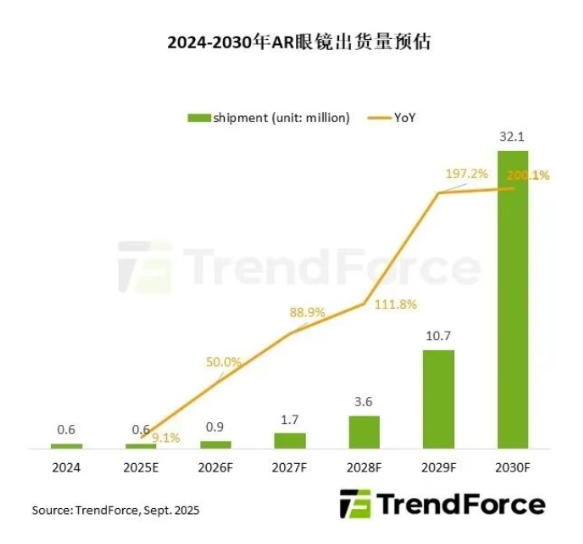11
2025
-
09
International giants like Meta are stepping up their investments, with AR glasses shipments projected to reach 32.1 million units by 2030.
According to the latest report released by TrendForce, 2025 Near-Eye Display Market Trends and Technology Analysis 》According to the report, as international brands gradually launch AR glasses prototypes in 2025—and with Meta expected to unveil its AR glasses model Celeste in the near term—market interest in AR devices is beginning to heat up. Coupled with the declining prices of OLEDoS products, global AR shipments are projected to reach 600,000 units by 2025.

In the long term, the information-guided AR market shows strong growth potential. Starting in 2028, as advanced full-color AR technologies continue to mature and international giants introduce increasingly sophisticated, well-designed products, shipments are expected to surge, reaching 32.1 million units by 2030. Regionally, China currently dominates shipments, but with tech behemoths like Meta and Google entering the market, China's share of global shipments is projected to decline to 50.2% by 2030.
TrendForce notes that AI technology is helping consumers develop a clearer vision of AR glasses applications, while also fostering the industry's gradual alignment on standardized specifications.
Take the light engine as an example: in response to consumer demands, brands are now requiring that the light engine’s power consumption be below 300mW, its drainage volume remain under 1cc, and its weight stay under 3g, among other specifications. For suppliers, while these requirements add further challenges to an already complex technology, they also help align standards across the industry.
Currently, the mainstream panel sizes for LEDoS and LCoS typically range from 0.13 to 0.18 inches, with pixel densities (PPI) exceeding 5,500 in both cases. While LEDoS resolutions fall between 640x480 and 720x720, LCoS resolutions generally stay around 720x720—meaning there’s no significant difference in specifications between the two technologies. Moreover, looking ahead, CMOS-based substrates are expected to see their sizes and designs move toward standardization in order to help control costs.
Although standardized specifications limit brand differentiation and the room for product iteration, standardization helps achieve economies of scale and reduce costs. Beyond enabling a more focused approach to overall device design and market positioning, it also makes it easier to align pricing with consumers' price expectations—thereby encouraging more potential users to enter the AR glasses market and fostering a positive feedback loop.
Meanwhile, major international companies like Meta and Google are actively investing, accelerating the development of the supply chain. With the addition of suppliers such as LUMUS, Goertek, JBD, Xreal, and Omnivision, these players are poised to benefit from market expansion while simultaneously strengthening the broader ecosystem—laying a solid foundation for achieving multi-million-unit shipments by 2030.


